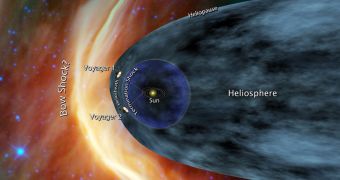Voyager 1, the fastest man-made object still in existence and the most distant one at this point, is about to become the first interstellar man-made object as well.
Exactly when it's going to happen is anyone's guess, there are signs that it is very close, but those depend on our understanding of that region at the edge of the Solar System which, obviously, is limited.
Some of the latest data would indicate that Voyager 1 is about to make the leap, but there's no official confirmation. In the meantime, scientists have a chance to test their theories about what that region of space is like.
And, as is usually the case, scientists are surprised to see that it's not quite as they expected.
Voyager is now at the very limits of the heliosphere, the magnetic field created by the sun that surrounds our Solar System and keeps out a large amount of highly energetic particles.
Voyager 1 is now in the heliosheath, a region where the solar winds have slowed down, almost completely, due to the pressure of outside space.
The sun's magnetic field should also begin to falter that far out and its effect should be less felt. Particularly, the magnetic fields surrounding Voyager 1 should be rather chaotic without the influence of the sun's field.
Measurements taken by Voyager's instruments during 2010 found that the magnetic field did start to fluctuate in strength and direction, as expected.
The theory also predicted that the number of high-energy particles detected should decrease in this zone, the chaotic magnetic field would scatter them decreasing the number of detections.
But the data showed that the number of detections increased in the region, the opposite of what astronomers expected.
They now believe that the magnetic field is actually the cause of this, the fluctuations are energizing existing particles explaining the increase in detections. The results of their study are published in AGU's Journal of Geophysical Research-Space Physics.

 14 DAY TRIAL //
14 DAY TRIAL //